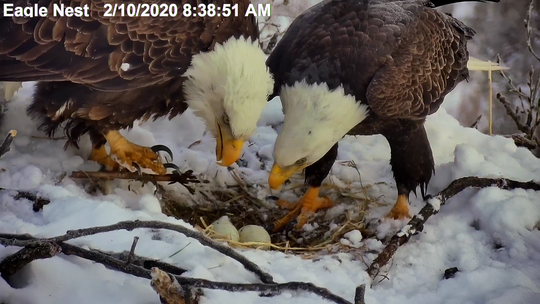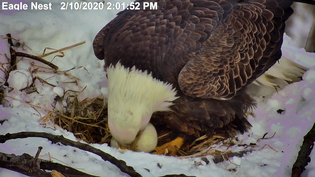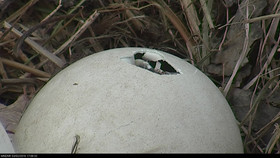|
February 14, 2020

They did it!
Just in time for Valentine's Day, our famous love birds at the EagleCam nest have now produced three eggs. These two have been around the nesting territory since January of last year, kicking the original eagle pair off of the nest. The new pair remained on the territory, always close to each other, nuzzling, feeding each other all spring and summer, but without producing any eggs. Until now! What perfect timing -- a Valentine's Day gift from the Minnesota Nongame Wildlife Program to you!
Their first egg arrived on Thursday, Feb. 6; the second came on Sunday, Feb. 9; and on Wednesday, Feb. 12, the third and likely final egg appeared.
Check out this video of the final egg being laid -- but be forewarned, it's graphic.

Eagles share their parenting duties. While the female does most of the incubation, both adults have a brood patch. The patch is a featherless spot of bare skin on their underside designed to help keep eggs warm. The male eagle will take over incubation duty periodically to allow the female time to stretch her wings, hunt and have a nice meal of frozen fish or fresh squirrel. Yum!
By this time, both birds have spent much time adding sticks and other materials to the nest. Sensing the impending cold temperatures, the male still is bringing in soft grass. The pair also has been digging a deeper bole, or nesting cavity, to keep the eggs warm. This deep bole makes it difficult to see the eggs, but helps keep them from freezing in the frigid Minnesota weather.
Snow and cold temperatures have caused concern among viewers. Let us alleviate your fears with some facts:
Embryos are less sensitive to cold than to heat, particularly before incubation has started. Mallard eggs have been known to crack by freezing and still hatch successfully. Eggs cool when incubation is interrupted, but this is not usually harmful, and few birds incubate continuously. Instead, egg temperature is regulated in response to changes in the temperature of the environment by varying the length of time that a parent bird sits on them, or by the tightness of the “sit.”
Many birds apparently sense the egg temperature with receptors in their brood patches, helping them regulate their attentiveness (time spent incubating) more accurately. Since the embryo itself increasingly generates heat as it develops, periods of attentiveness should generally decline as incubation progresses. Attentiveness also is influenced by the insulating properties of a particular nest.
|
Incubation of the eagle eggs goes on for about 35 days. A few days before they emerge, the chicks will begin scraping the inside of the shell with their egg tooth, a small horny protuberance on the top of their beak. That creates a thin spot in the shell that they can start to break through, first with a small hole, or pip, that begins the hatching process. |
|
 |
It's not every day that a person gets to see, up close and personal, something as amazing as a bald eagle actually laying an egg. And in just over a month, we hopefully will get to see the miracle of eagle chicks emerging from their shells. These privileged insights into the natural world are possible only because people like you have shown their love for wildlife by donating to the Minnesota Nongame Wildlife Program. Thanks!
|